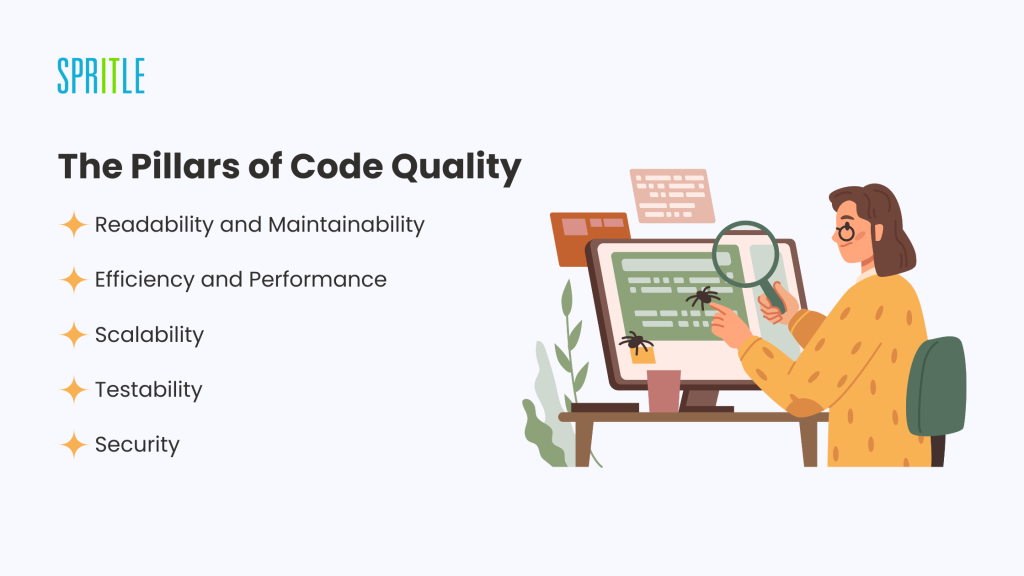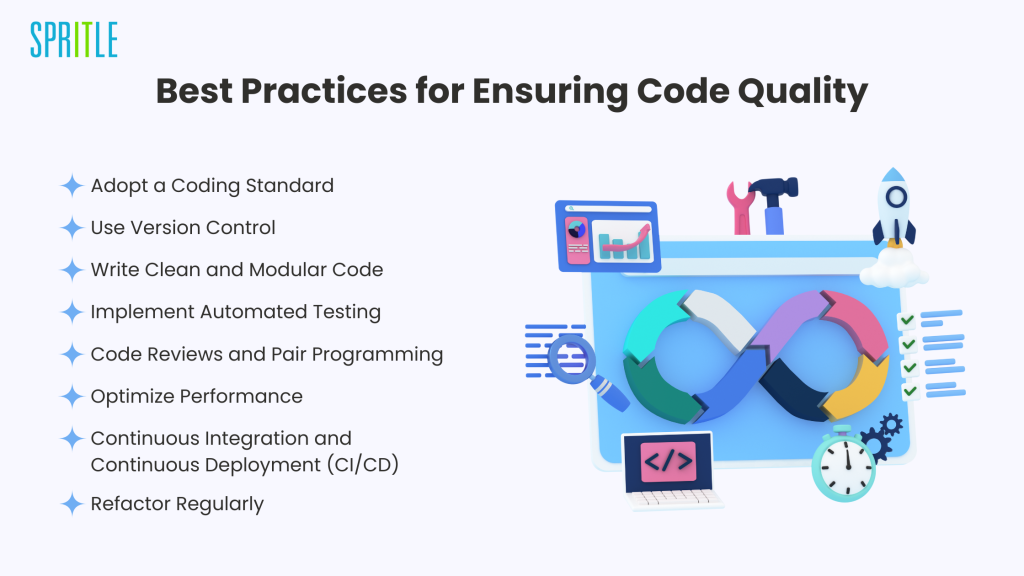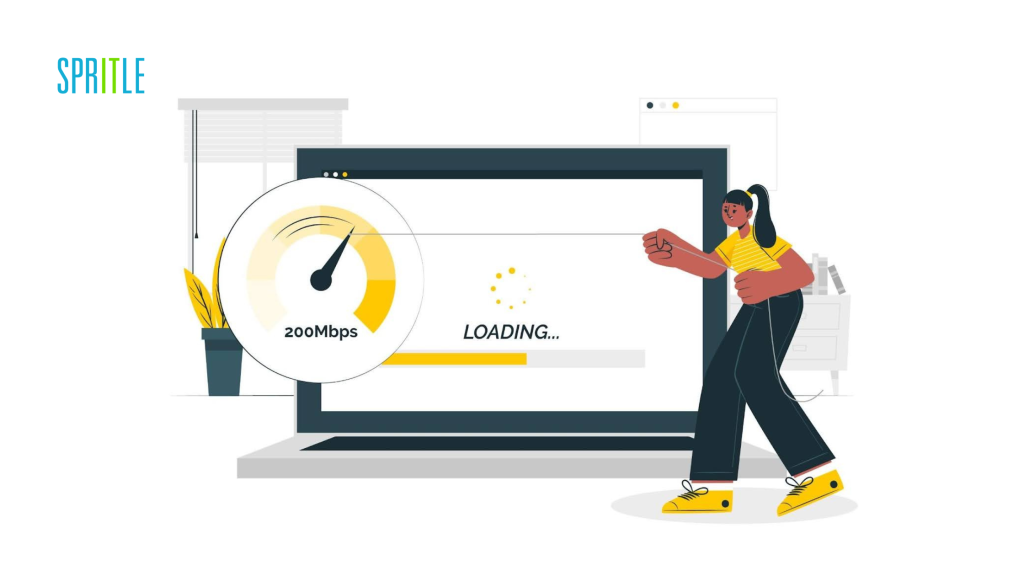
Introduction
In the realm of software development, code quality stands as a pivotal aspect that influences the performance, maintainability, and scalability of applications. For front-end developers, ensuring code quality is not just a best practice but a necessity to achieve performance efficiency and create seamless user experiences. This blog delves into the critical facets of code quality, highlighting its significance in software development, particularly in front-end development.
Understanding Code Quality
Code quality refers to the degree to which code adheres to various attributes that define its efficiency, readability, maintainability, and performance. High-quality code is not only functional but also easy to understand, modify, and extend. It minimizes bugs, reduces technical debt, and enhances the overall performance of the application.
The Pillars of Code Quality
1. Readability and Maintainability
Maintainability refers to the ease with which code can be updated or enhanced. Modular code, where functionality is divided into reusable components, significantly improves maintainability
Maintainability refers to the ease with which code can be updated or enhanced. Modular code, where functionality is divided into reusable components, significantly improves maintainability
2. Efficiency and Performance
Efficient code performs tasks using the least amount of resources possible. This includes optimal memory usage, processing power, and time.
Performance efficiency in front-end development ensures that web applications load quickly and run smoothly, providing a better user experience.
3. Scalability
Scalable code can handle increased loads without significant changes. This is crucial for applications that expect growth in user base or functionality over time.
4. Testability
Code that is easily testable ensures that functionalities can be validated through automated or manual testing. High test coverage reduces the likelihood of bugs and errors in production.
5. Security
Secure code protects against vulnerabilities and potential attacks. Implementing best practices in coding standards can prevent common security issues like SQL injection and cross-site scripting (XSS).

Code Quality in Front-End Development
Front-end development focuses on the user interface (UI) and user experience (UX), making code quality paramount for several reasons:
1. User Experience
High-quality front-end code ensures a responsive and interactive user experience. Smooth transitions, minimal load times, and a consistent look and feel across different devices and browsers are indicators of good code quality.
2. Performance Efficiency
Efficient front-end code reduces load times and improves the overall performance of web applications. Techniques like lazy loading, code splitting, and optimizing images and assets contribute to performance efficiency.
3. Maintainability and Scalability
As user interfaces evolve, maintaining and scaling front-end code becomes challenging. Adhering to best practices in code organization and using frameworks like React, Angular, or Vue.js can help manage this complexity.
4. Cross-Browser Compatibility
Ensuring that the application functions correctly across different browsers requires meticulous attention to code quality. This involves thorough testing and adhering to web standards.

Best Practices for Ensuring Code Quality
1. Adopt a Coding Standard
Establishing and adhering to a coding standard ensures consistency across the codebase. Popular standards include Airbnb’s JavaScript Style Guide and Google’s JavaScript Style Guide.
2. Use Version Control
Tools like Git enable version control, allowing developers to track changes, collaborate effectively, and revert to previous states if necessary.
3. Write Clean and Modular Code
Break down functionalities into smaller, reusable components. This not only improves readability and maintainability but also enhances testability.
4. Implement Automated Testing
Use testing frameworks like Jest, Mocha, or Jasmine to write automated tests for your code. Unit tests, integration tests, and end-to-end tests help ensure that the code behaves as expected.
5. Code Reviews and Pair Programming
Conduct regular code reviews to catch issues early and share knowledge among team members. Pair programming can also foster collaboration and improve code quality.
6. Optimize Performance
Utilize performance optimization techniques like minifying CSS and JavaScript files, compressing images, and leveraging browser caching. Tools like Lighthouse can help audit and improve web performance.
7. Continuous Integration and Continuous Deployment (CI/CD)
Implement CI/CD pipelines to automate the process of testing, building, and deploying code. This ensures that changes are consistently integrated and delivered without manual intervention.
8. Refactor Regularly
Refactoring involves restructuring existing code without changing its external behavior. Regular refactoring helps maintain code quality by improving readability, reducing complexity, and addressing technical debt.

Ensuring Usefulness and Maintainability
Code quality is about more than just writing functional code; it’s about writing code that is useful and maintainable in the long term. While the distinction between good and bad code can be subjective, low or poor-quality code is universally difficult to test and maintain. Maintaining code quality is a challenging process, but adopting a qualitative approach is the best method to achieve this goal.
Efficiency is directly proportional to performance. Using proper error handling and exception methods can play a crucial role in the development process, making the code reliable and robust. Robustness, which deals with errors and unusual conditions, is achieved by testing the code in different and unusual conditions. When writing any code, it should attain high quality and maintain features that align with standard practices. The code should be easily refactored, making it easier to implement modifications and changes in the future without disturbing the existing functionality.
Enhancing Page Load Performance
Making page loading fast creates a significant difference in performance. Faster load times are directly proportional to better performance, enhancing the user experience. Reducing page load times can be effectively achieved by using a Content Delivery Network (CDN). CDNs distribute the content across various servers worldwide, reducing the distance between the user and the server, and hence, speeding up the load time.

Conclusion
Ensuring code quality is a continuous process that involves a combination of best practices, tools, and a commitment to excellence. For front-end developers, the stakes are particularly high as the user experience hinges on the performance and reliability of their code. By focusing on readability, efficiency, maintainability, and security, developers can create high-quality code that stands the test of time and delivers exceptional performance.
In the ever-evolving landscape of software development, prioritizing code quality is not just a technical requirement but a strategic imperative. It lays the foundation for performance efficiency, scalability, and a superior user experience, ultimately contributing to the success of the application and satisfaction of its users.
By embracing these principles and leveraging the right tools, developers can ensure that their code not only meets the functional requirements but also excels in quality, paving the way for robust and high-performing applications.
